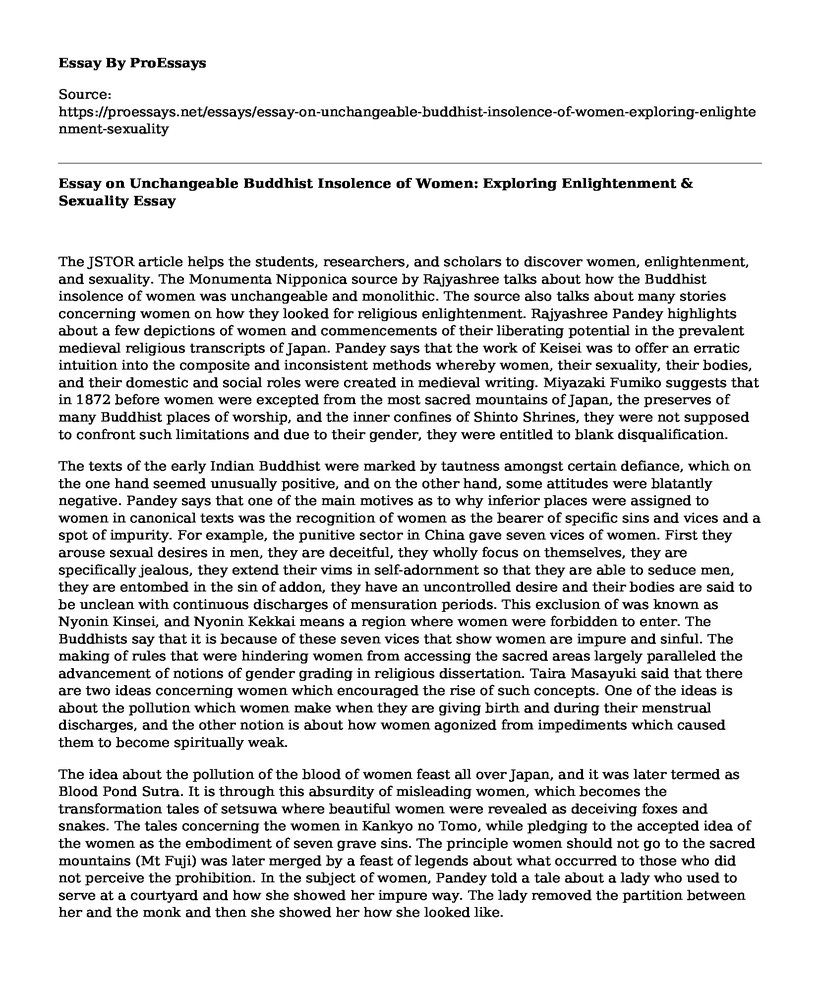The JSTOR article helps the students, researchers, and scholars to discover women, enlightenment, and sexuality. The Monumenta Nipponica source by Rajyashree talks about how the Buddhist insolence of women was unchangeable and monolithic. The source also talks about many stories concerning women on how they looked for religious enlightenment. Rajyashree Pandey highlights about a few depictions of women and commencements of their liberating potential in the prevalent medieval religious transcripts of Japan. Pandey says that the work of Keisei was to offer an erratic intuition into the composite and inconsistent methods whereby women, their sexuality, their bodies, and their domestic and social roles were created in medieval writing. Miyazaki Fumiko suggests that in 1872 before women were excepted from the most sacred mountains of Japan, the preserves of many Buddhist places of worship, and the inner confines of Shinto Shrines, they were not supposed to confront such limitations and due to their gender, they were entitled to blank disqualification.
The texts of the early Indian Buddhist were marked by tautness amongst certain defiance, which on the one hand seemed unusually positive, and on the other hand, some attitudes were blatantly negative. Pandey says that one of the main motives as to why inferior places were assigned to women in canonical texts was the recognition of women as the bearer of specific sins and vices and a spot of impurity. For example, the punitive sector in China gave seven vices of women. First they arouse sexual desires in men, they are deceitful, they wholly focus on themselves, they are specifically jealous, they extend their vims in self-adornment so that they are able to seduce men, they are entombed in the sin of addon, they have an uncontrolled desire and their bodies are said to be unclean with continuous discharges of mensuration periods. This exclusion of was known as Nyonin Kinsei, and Nyonin Kekkai means a region where women were forbidden to enter. The Buddhists say that it is because of these seven vices that show women are impure and sinful. The making of rules that were hindering women from accessing the sacred areas largely paralleled the advancement of notions of gender grading in religious dissertation. Taira Masayuki said that there are two ideas concerning women which encouraged the rise of such concepts. One of the ideas is about the pollution which women make when they are giving birth and during their menstrual discharges, and the other notion is about how women agonized from impediments which caused them to become spiritually weak.
The idea about the pollution of the blood of women feast all over Japan, and it was later termed as Blood Pond Sutra. It is through this absurdity of misleading women, which becomes the transformation tales of setsuwa where beautiful women were revealed as deceiving foxes and snakes. The tales concerning the women in Kankyo no Tomo, while pledging to the accepted idea of the women as the embodiment of seven grave sins. The principle women should not go to the sacred mountains (Mt Fuji) was later merged by a feast of legends about what occurred to those who did not perceive the prohibition. In the subject of women, Pandey told a tale about a lady who used to serve at a courtyard and how she showed her impure way. The lady removed the partition between her and the monk and then she showed her how she looked like.
Conclusion
In conclusion, the segregation of women had a history at Mt Fuji. When the worshipping area of women which was abandoned for many decades was revived, it memorialized the hard work of women who wriggled at the base of the mountain to go closer to the summit.
Cite this page
Essay on Unchangeable Buddhist Insolence of Women: Exploring Enlightenment & Sexuality. (2023, Jan 23). Retrieved from https://proessays.net/essays/essay-on-unchangeable-buddhist-insolence-of-women-exploring-enlightenment-sexuality
If you are the original author of this essay and no longer wish to have it published on the ProEssays website, please click below to request its removal:
- Instances Proving That Women Are Treated Inferior to Men in Handmaid's Tale
- Women Better Than Men in Education - Controversial Essay
- From Jesus to Christ Essay
- Essay Sample on A Significant Issue in Education
- Essay Example on Joe the King: 14-Year-Old Struggling in Abusive Family
- Exploring Confucianism: A Chinese Way of Life - Essay Sample
- Reggie and Addison's House Party: A Conversation on Racism - Free Paper







